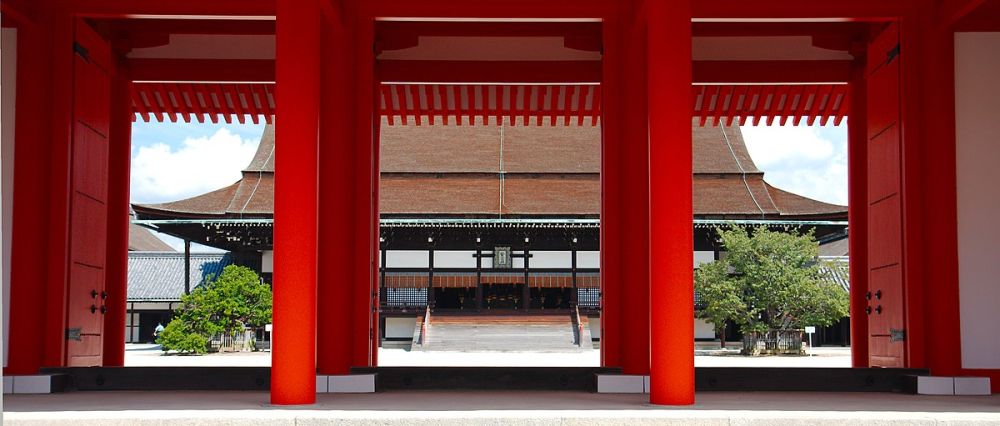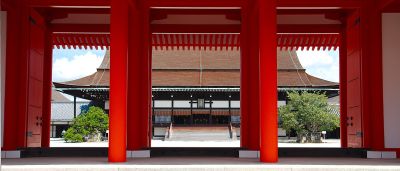

Explore the former residence of the Imperial Family, the Kyoto Imperial Palace, with an expert guide leading the way. This comprehensive tour goes beyond the usual tourist path, allowing for a deeper understanding of the palace's history, architecture, and cultural significance. Visitors will marvel at the beautiful gates, classic Japanese gardens, and elegant palace buildings. The tour usually includes the main gate, the Shishinden (Ceremonial Hall), Seiryoden (Living quarters), Kogosho (Court functions), Ogakumonsho (Imperial study or library), and the enchanting Otsunegoten, which is constructed in the Shinden-zukuri architectural style synonymous with Heian Period nobility residences. The serenity and exquisite maintenance of the grounds complement the profound experience of connecting with Japan's royal heritage. The duration of the guided tour may vary, but it typically lasts for about one to one and a half hours.
The Kyoto Imperial Palace is renowned not only for its historical buildings but also for its stunning gardens that illustrate traditional Japanese garden design. As you meander through the expansive grounds, you'll encounter various landscaping styles from different eras, each narrated by the diverse flora and ornamentation on display. Highlights include the serene ponds, carefully raked gravel gardens, and flowering cherry and plum trees, which offer a particularly breathtaking spectacle during the spring bloom. Maple trees brighten autumn with a vibrant display of colors. Each step through this tranquil oasis provides a contemplative experience, reflecting the beauty and elegance of imperial Japan. You can complete a leisurely walk through the gardens in an hour or extend your visit to fully immerse yourself in the peaceful atmosphere.
Capture the splendor of the Kyoto Imperial Palace through your lens with a self-guided photography session. The palace offers a plethora of stunning scenes, from the detailed architecture of the ancient structures to the delicate landscaping of the gardens. Enthusiasts and professionals alike can take advantage of the unique lighting at different times of the day to shoot the perfect photograph. Whether you're seeking to capture the warm glow of dawn casting long shadows across the gravel paths, the bright midday sun illuminating the vermilion gates, or the golden hues of dusk reflecting on the pond's surface, the palace grounds provide a magnificent backdrop. Remember, tripods are often not allowed on the premises, and visitors must be considerate of others and the historical environment while carrying out their photography sessions.
The area surrounding the Kyoto Imperial Palace regularly hosts a range of cultural workshops and hands-on experiences designed to educate tourists about traditional Japanese arts and culture. Options might include a Japanese calligraphy class, a kimono-wearing experience, or a tea ceremony demonstration. In these workshops, visitors have the opportunity to immeran appointment or ticket to participate.
Kyoto Imperial Palace's schedule is dotted with seasonal events and festivals that celebrate Japan's rich customs and natural beauty. During the spring, the palace's cherry blossoms draw in countless admirers for hanami, the traditional cherry blossom viewing. In autumn, the turning of maple leaves into fiery shades of red and orange provides a stunning visual feast, sometimes marked by special evening illumination events. Furthermore, festivals such as Shichigosan, a rite of passage for young children, or cultural demonstrations, such as ancient court music and dance performances, are held throughout the year. These events encourage a deeper cultural understanding and provide a spectacular show of Japan's enduring traditions.
The surrounding Kyoto Imperial Park, a vast expanse of open green space, offers a perfect route for a refreshing jog or run. The park's wide pathways are lined with trees and provide a relaxed setting away from the city's hustle. Joggers can enjoy a mix of well-maintained gravel and paved paths that meander around the historical palace grounds. The running route showcases a mix of nature and history, giving you the chance to exercise while taking in the sights of ancient Japanese architecture and serene garden landscapes. The whole circuit around the park is approximately 4 kilometers, but it can easily be extended for a longer workout or shortened for a quick run.
Kyoto Imperial Palace's extensive grounds are an ideal spot for a leisurely picnic. Visitors can find a quiet area on the lush grass or under the shade of graceful trees to lay down their picnic mats. The palace lawns are well-manicured, and the environment is peaceful, allowing for a relaxing break amidst the sightseeing. Many local residents and tourists alike enjoy bringing a bento box and some snacks to savor while immersed in the historical atmosphere of the palace. The experience is particularly enjoyable during the cherry blossom season when the palace gardens are in full bloom. However, visitors should check local regulations regarding picnicking and ensure they leave no trash behind to maintain the pristine condition of the palace gardens.
For those interested in the artifacts and artwork associated with Japan's imperial history, the Kyoto Imperial Palace occasionally features exhibitions showcasing pieces from the Imperial Collection. These temporary displays can include a variety of items such as antique furnishings, historic documents, precious textiles, and art that belonged to the Imperial Family. The chance to view these meticulously preserved treasures up close provides insight into the luxurious lifestyle and cultural patronage of the Japanese court. Signage and audio guides may be available to give context to the artifacts on display, enhancing the educational value of your visit.
Occasionally, the Kyoto Imperial Palace hosts lectures and presentations that focus on the site's historical significance and the broader context of Japan's imperial history. These educational activities are a draw for history buffs and those looking to gain a deeper understanding of the palace's role throughout the centuries. The talks are typically given by scholars or experts in the field of Japanese history and culture. Depending on the event, you may need to reserve a spot in advance or purchase a ticket. The lectures can vary in length, but they generally last about an hour and provide an excellent opportunity to ask questions and engage with the material in a meaningful way.
Artists and aspiring sketchers can bring their materials to the Kyoto Imperial Palace for a quiet day of drawing and painting. Whether you're interested in the subtle details of Japanese garden design or the grandeur of traditional architecture, the palace grounds offer endless inspiration. With ample seating and vantage points, it's easy to find a comfortable spot to settle down and create your artwork. The activity is self-guided, allowing you to take as much time as required to capture the scenes before you. Sketching within the palace grounds can be a peaceful way to connect with the environment and create a unique, personal memento of your visit to this historic site.
